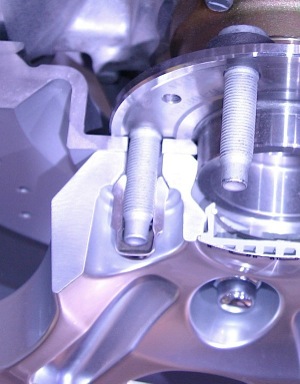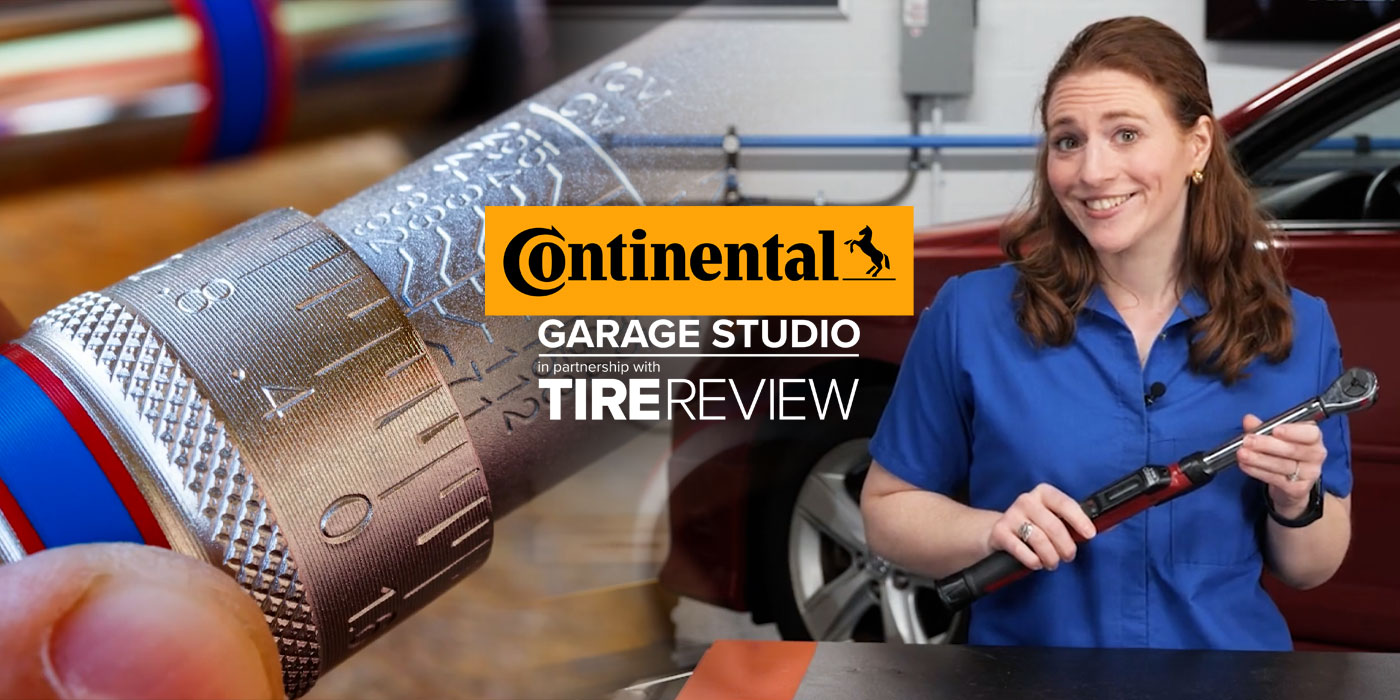It’s not difficult totorque wheel fasteners properly, but it’s not difficult to foul up the job,either. We’re not using double talk here; we’re shootin’ straight from the hip.The easy part of proper wheel fastener torquing is knowing the vehiclemanufacturer torque specifications for a particular passenger car, light truckor medium truck, and following those instructions to the letter.
Fastener torquespecifications can be found in the owner’s manual of the vehicle in question.By simply following those specifications, you can avoid unwanted comebacks. 
Today’s wheelfasteners are primarily a straight-tapered seat type, which is torqued into analloy wheel that has a hardened seat. In this case, the wheel fastener matchesthe taper of the bolt hole in the wheel. As this type of wheel fastener istightened, it is driven into the hole, thus acting as a wedge. This force isresponsible for keeping the wheel attached to the vehicle.
MushroomingProblems
Also making life alot easier is the move away from steel wheels to much stronger alloy wheels.Although some steel wheels remain, the issue of “mushrooming” a wheel fastenerinto a wheel until the lug-nut material and the threads of the wheel arepractically married is just about ancient history.
Still, an overzealoustire tech and an impact wrench running off shop line pressure of 150 psi caneasily generate 120- to 130-foot-pounds of torque, far more than necessary fortoday’s wheels. Any tech still torquing fasteners in that manner runs the riskof causing uneven pressure on the brake rotor.
How? In the interestof saving time, the tech may over-torque one or more wheel fasteners to thepoint that they distort the brake rotor. The power of over-tightening a wheelfastener should not be underestimated. Those using an impact wrench exclusivelymay cause a pulsating brake pedal and premature brake wear. Customers don’tlike that.
Further, using animpact wrench with a machine-gun approach can put the kind of stress on a wheelor wheel stud that can cause it to crack or weaken, preparing the way forfuture failure.
Metal changes itscharacteristics when placed under extreme stress or heat. Wheel fasteners aremade to meet a certain strength level, along with the ability to withstand “X”amount of torque. Exceeding the torque load limit will cause wheel fasteners tostretch and ultimately fail. That’s the bad news.
Here’s the good news.Gear back the impact wrenches in your outlet to 30- to 40-foot-pounds to seatthe wheel fasteners, and then adjust to the final torque specifications with atorque wrench, or torque stick, as it’s called. Your job, and the job of yourtechs, is to be 100% correct in tightening down wheel fasteners to manufacturerspecifications.
MonsterTorque
We all remember thedays of torquing a wheel fastener to 110-foot-pounds. Not only did we have touse an impact wrench to undo our work, the poor consumer had no chance ofloosening those wheel fasteners when a tire went down. Even with a star wrenchand the brute strength of a Mike Tyson, it was possible to rotate the entiretire/wheel assembly without ever loosening the wheel fastener.
Although it hardlyseems possible given those vivid memories, the truth is that the averagefoot-pounds of torque needed to keep today’s wheel fasteners safely in place isbetween 65- and 80-foot-pounds. Again, that’s on average. To many of us, thisdoesn’t seem like enough torque to keep the tire/wheel assembly from leavingthe vehicle on which it is mounted.
Looking a bit deeper,we all know torque must be applied evenly when working with wheel fasteners.Yet, how many of us still use an air wrench and a socket until we feel – as in“gut feel” – that the job is done? That’s a bad idea. Failing to use a torquestick on every wheel fastener means a tech is going to fall short of being 100%correct. In fact, failure to complete proper wheel torquing is right up therewith improper tire inflation as one of the most overlooked tire maintenanceissues.
TroubleSpots
Your shop should notonly torque to specs, you should also inspect the threads and mating surfacesto ensure everything will fit clean and snug onto clean, uniform surfaces.
Another trouble spotcan occur if wheel fasteners are not OE. When remounting a tire/wheel assembly,make sure the wheel fastener is absolutely compatible with the type of seatinto which it will be torqued. Check the fastener thread engagement. Every studmust be long enough to accommodate a wheel fastener’s length and diameter.Sounds simple, but some people miss this point.
It’s a must to checkand retorque all fasteners on a new installation after the first 50-100 milesof use. Failure to retorque is unsafe for the motorist and could cause damageor injury. Also, retorquing must be done any time wheel fasteners are removedfor any reason.
This strongsuggestion is offered just in case the wheel fasteners are not fastened in aneven-load distribution pattern. A concentrated torquing load often occurs onthe first wheel fastener the tech touches. When this area is drawn tightagainst the hub, a warped center section of the wheel is a possibility.
Once the wheel heatsup, that set can become a permanent characteristic of the wheel. Hence, therule of thumb to retorque all wheel fasteners after the first 50 miles of use.
All of this playsinto something you may hear far too often: “I have a vibration in my car.” Thatis often followed by premature tire wear and brake pedal pulsation. In fact,some say the number-one cause of brake pedal pulsation is uneven wheel fastenertorque.
A difference of 20percent between any two-wheel fasteners is too much. Try solving this problemby loosening all the wheel fasteners, cleaning the stud threads, lightlycoating them and the nut chamfer with clean engine oil and reinstalling thewheel fasteners finger-tight or with a geared-back impact wrench
Then, using acrisscross pattern, retorque every wheel fastener to about one-third of thespecified torque setting, then to two-thirds and finally to the specifiedtorque.
Is there more to thissubject? There’s always more. But, we don’t expect you to be advanced-degreemechanical engineers or metallurgists.
Instead, make propertire inflation and wheel torquing part of your tire service policy. Put it onpaper, and make sure techs adhere to it every time they tighten wheelfasteners. It’s just good business sense.
I ran across a “pennypincher” consumer website for misers, cheapskates and skinflints. Aside fromthe tip about keeping a phone book in your car so you can check prices for thebest tow truck rate, the website had a tip about anti-seize and lug nuts. Thetip was written by a non-credited source and it advised drivers to “spend anafternoon” applying anti-seize to all the studs to make it easier to remove thelug nuts.
If you encounter oneof these vehicles with anti-seize on the wheel studs, be very careful. Taketime to explain to the driver why anti-seize is bad and how it can causeproblems. Also, advise them that there is a potential for failure during normalservice. You should also put it on the repair order.
Is there a right wayto use lubricants around the wheel? Yes, but it has to be a high-temperaturelubricant used only in a very light coating. First, a high-temperaturelubricant can be used where the hub goes through the center of the wheel. Manyvehicles use the hub to center the wheel. These “hub-centric” designs can benefitfrom a very light coating.
On some conical lugnuts, you can put a light coating on the seating surfaces of the cone, whileavoiding any contamination with the threads. This coating can preventcorrosion.













